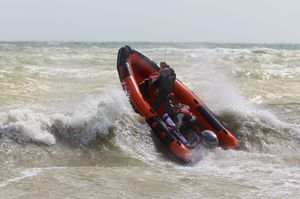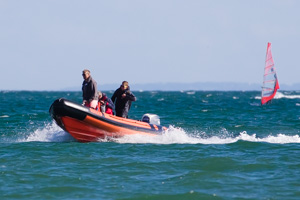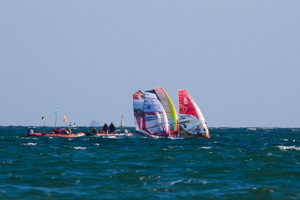Racing Crew
First on the water and always the last off!
A day in the life from the crew's point of view, from Sue Deverell.
 I’ve been part of the UKWA Race Team for four years now and I love it! I really can't explain why, especially when its tipping with rain or rough seas with 6 foot waves, but I'd rather be out on the boat than hiding in the van. The lads are real professionals, great fun and we each do our bit to make the weekends run smoothly!. If it all gets a bit rough I know I can trust the lads to keep us all safe.
I’ve been part of the UKWA Race Team for four years now and I love it! I really can't explain why, especially when its tipping with rain or rough seas with 6 foot waves, but I'd rather be out on the boat than hiding in the van. The lads are real professionals, great fun and we each do our bit to make the weekends run smoothly!. If it all gets a bit rough I know I can trust the lads to keep us all safe.
Early Saturday morning while I'm still in bed contemplating how many socks, fleeces and seasick pills I will need, the lads are already sorting the boats out, launching at a marina or slipway and inflating the buoys. I pack my wet bag with lunch, water, change of clothes, extra spray top and change into my dry suit and boots ready for the briefing. While I'm wandering around the site with my dry suit tried around my waist, the sailors realise that we will be on the water soon and frantically rig sails. My son realises it's now time to get out of bed and rig up!
After the briefing we go down to the water's edge for my most exacting part of the day, trying to get into the rib! We usually wade out to waist depth, making sure the dry suits are zipped up, with our wet bags held high, and throw the bags into the boat. It's not advisable to take a flask of coffee as it won't survive the journey! Also, once we're zipped into our dry suits, we tend to stay in them all day, so too much coffee isn't a good idea! Then we hoist ourselves up into the boat, trying not to get battered by the waves. Usually there are willing helpers already in the RIB, who haul us aboard and we slither elegantly into the bottom of the boat, trying not to land on the anchor. Our SOLA dry suits are fantastic, but next time can we have handles on our bottom, so we can be hoisted into the boat more easily!
 Once aboard, we speed off to the Committee boat, which is usually at anchor further out where the racing will take place. Clambering onto the Committee boat is usually much easier, although I did once find myself with one leg on one boat and the other on a departing RIB, with everyone laughing, as I attempted not to fall in! You only ever do that once! Then the housekeeping starts – check the flags and put them in an easily accessible place, the floor! Secure the hooter system and attach the horns onto the back of the boat, ready to deafen any passing juniors who get too close! We need paper and pens for the results, with wet pads and chinagraph pencils when it is very rough. When we are set up and the course is laid we are ready to race. I'm usually in charge of the hooters (!) and the stopwatch, so I position myself anywhere I can concentrate without being hit on the head by a passing rig. A loud hoot informs the racers that the F flag is up, in preparation for imminent racing and everyone is now alert for the approaching flag sequence. Those near enough to the boat set their watches by the hooter so they can get a good start. The Class flag goes up and the sailors check their transits, hopefully choosing an immovable object on shore and not a sheep! (my daughter did this once and the sheep wandered off!)
Once aboard, we speed off to the Committee boat, which is usually at anchor further out where the racing will take place. Clambering onto the Committee boat is usually much easier, although I did once find myself with one leg on one boat and the other on a departing RIB, with everyone laughing, as I attempted not to fall in! You only ever do that once! Then the housekeeping starts – check the flags and put them in an easily accessible place, the floor! Secure the hooter system and attach the horns onto the back of the boat, ready to deafen any passing juniors who get too close! We need paper and pens for the results, with wet pads and chinagraph pencils when it is very rough. When we are set up and the course is laid we are ready to race. I'm usually in charge of the hooters (!) and the stopwatch, so I position myself anywhere I can concentrate without being hit on the head by a passing rig. A loud hoot informs the racers that the F flag is up, in preparation for imminent racing and everyone is now alert for the approaching flag sequence. Those near enough to the boat set their watches by the hooter so they can get a good start. The Class flag goes up and the sailors check their transits, hopefully choosing an immovable object on shore and not a sheep! (my daughter did this once and the sheep wandered off!)
 One minute to go; no-one over the line we hope, or they have to go round the ends; 30 seconds, 20 seconds, countdown from 10 seconds and GO!! Everyone speeds across the line towards the windward mark (hopefully). All clear, no need for the general or individual recall flags this time. Now we can relax a bit, watch the racing and check for any problems.
One minute to go; no-one over the line we hope, or they have to go round the ends; 30 seconds, 20 seconds, countdown from 10 seconds and GO!! Everyone speeds across the line towards the windward mark (hopefully). All clear, no need for the general or individual recall flags this time. Now we can relax a bit, watch the racing and check for any problems.
The lads do a great job rescuing stricken sailors and dispatching them to the shore: they know the best way to get you and your kit back safely, so listen to them and take notice. We watch the progress of the racing and get ready to take results; two of us note them down separately to make sure that we get it right. Please make sure your sail numbers are EASY to read. We sometimes have a bunch of sailors over the finish at once and we need to see you all! You might not get the result you want if you are marked down as ? We double check the results and send them back to shore, once everyone has finished. We aim to complete at least four races a day depending on conditions and timing, but we must consider the boat crews who have to get the boats out at the end of the day, this can take up to three hours, after the racing has finished. They can't leave the race course until everyone has posted their tallies, and there is always one who is still wearing his in the shower!
Usually we get dropped off at the beach after racing, this involves the rib coming into the beach as near as possible and then we climb over the side, hoping we don't disappear under the water. How deep did you say it was?
That's one day of racing finished, back to the van to shower, change and recover. Yes please, mine's a gin and tonic! Oh and a cuppa.
The next morning it all starts again, the same routine but probably earlier so we can get plenty of racing in before everyone heads home.
I've been all over the country and worked on all types of committee boats, from the "plastic pig" to the "sick boat" (in Pwllheli, named thus by the locals, can't think why!) and I'll be back for more next year. See you there.
Sue Deverell
